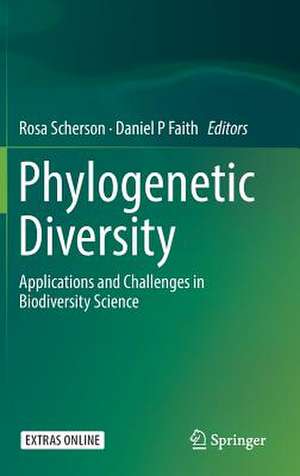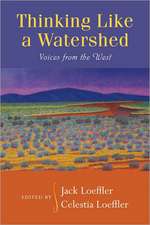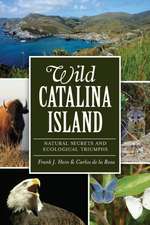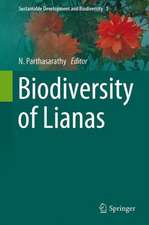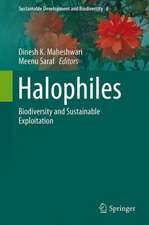Phylogenetic Diversity: Applications and Challenges in Biodiversity Science
Editat de Rosa A. Scherson, Daniel P Faithen Limba Engleză Hardback – 11 sep 2018
This increased appreciation of the importance of conserving “phylogenetic diversity”, from microbial communities in the human gut to global threatened species, has inevitably resulted in an explosion of new indices, methods, and case studies. This book recognizes and responds to the timely opportunity for synthesis and sharing experiences in practical applications. The book recognizes that the challenge of finding a synthesis, and building shared concepts and a shared toolbox, requires both an appreciation of the past and a look into the future. Thus, the book is organized as a flow from history, concepts and philosophy, through to methods and tools, and followed by selected case studies. A positive vision and plan of action emerges from these chapters, that includes coping with inevitable uncertainties, effectively communicating the importance of this “evolutionary heritage” to the public and to policy-makers, and ultimately contributing to biodiversity conservation policy from localto global scales.
| Toate formatele și edițiile | Preț | Express |
|---|---|---|
| Paperback (1) | 941.50 lei 43-57 zile | |
| Springer International Publishing – 8 feb 2019 | 941.50 lei 43-57 zile | |
| Hardback (1) | 947.50 lei 43-57 zile | |
| Springer International Publishing – 11 sep 2018 | 947.50 lei 43-57 zile |
Preț: 947.50 lei
Preț vechi: 1155.48 lei
-18% Nou
Puncte Express: 1421
Preț estimativ în valută:
181.30€ • 189.80$ • 150.02£
181.30€ • 189.80$ • 150.02£
Carte tipărită la comandă
Livrare economică 07-21 aprilie
Preluare comenzi: 021 569.72.76
Specificații
ISBN-13: 9783319931449
ISBN-10: 331993144X
Pagini: 252
Ilustrații: XII, 217 p. 53 illus., 31 illus. in color.
Dimensiuni: 155 x 235 mm
Greutate: 0.5 kg
Ediția:1st ed. 2018
Editura: Springer International Publishing
Colecția Springer
Locul publicării:Cham, Switzerland
ISBN-10: 331993144X
Pagini: 252
Ilustrații: XII, 217 p. 53 illus., 31 illus. in color.
Dimensiuni: 155 x 235 mm
Greutate: 0.5 kg
Ediția:1st ed. 2018
Editura: Springer International Publishing
Colecția Springer
Locul publicării:Cham, Switzerland
Cuprins
Acknowledgements.- Introduction Rosa A. Scherson and D.P. Faith.- Chapter 1. Phylogenetic diversity and conservation evaluation: perspectives on multiple values, indices, and scales of application D.P. Faith.- Chapter 2. The use of EDGE (Evolutionary Distinct Globally Endangered) and EDGE-like metrics to evaluate taxa for conservation Nick J.B. Isaac and William D. Pearse.- Chapter 3. Biodiversity, the tree of life, and science communication James Rosindell and Yan Wong.- Chapter 4. Indicators for the expected loss of phylogenetic diversity D.P Faith et al.- Chapter 5. Phylogenetic Resolution and Metrics of Biodiversity and signal in Conservation Nathan G. Swenson and Samantha J. Worthy.- Chapter 6. Phylogeny-based measurements at global and regional scales Shawn W. Laffan.- Chapter 7. Phylogeny-based measures of biodiversity when data is scarce: Examples with the vascular flora of Chile and California Rosa A. Scherson et al.- Chapter 8. Priority Areas for phylogenetic diversity: maximizing gains in the Mediterranean basin Simon Veron et al.- Chapter 9. Evolutionary diversity patterns in the Cape flora of South Africa Félix Forest et al.- Chapter 10. Effects of phylogenetic diversity and phylogenetic identity in a restoration ecology experiment Andrew L. Hipp et al.
Recenzii
“For anyone who wants a single volume on PD in conservation and its applications, this text provides a broad overview of the topic.” (Matthew R. Helmus, The Quarterly Review of Biology, Vol. 94 (3), 2019)
Notă biografică
Dr. Faith did his first degree in Mathematics, at the University of Chicago. He adopted a biology “sub-major”, pursuing courses on genetics and population biology. That prompted further study at Stony Brook, Ecology and Evolution, for his PhD work, on speciation and geographic variation in aphids. Dr. Faith’s research over the past 30 years or so could be described as mathematical biodiversity science. His research at the Australian Museum integrates biodiversity and systematics, including "biodiversity informatics". It is concerned with theory and applications of quantitative biodiversity assessment, extending from the scale of genes to whole countries, with special emphasis on the best-possible use of Museum collections in regional biodiversity assessment, and to the links from biodiversity assessment to ecosystem services, sustainability, and economics. Dr. Faith’s work on "phylogenetic diversity" and conservation is considered semial in the field, his original 1992 work accumulated more than 1000 citations, making it the most-cited paper ever in Biological Conservation from more than 7000 papers spanning 40 years. Other work in phylogenetics involves development and application of phylogenetic methods, and philosophy of science. He also does editorial work for Systematic Biology. Dr. Faith is an Adjunct associate professor at Sydney University and at the University of New England.
Dr. Scherson is an Associate Professor at the University of Chile, at the Faculty of Forest Sciences and Nature Conservation. Her research has focused on phylogenetic systematics of Chilean flora, with a special focus on endemic taxa. In the last 5-6 years she has developed an interest in studying phylogeny-based measures for conservation and their application as tools for evaluating taxa and ecosystems for conservation purposes. She has studied patterns of phylogenetic diversity and endemism in Chilean endemic and native flora,and has published the first evaluations of these parameters in Chile. She has also studied the way in which centres of high phylogenetic diversity and endemism are being protected by the state protected area system, and has been a consultant in these topics by the Ministry of the Environment in Chile. Lately Dr. Scherson’s interest has also focused on public data availability for phylogenetic diversity studies and how to efficiently use different types of data bases to aid conservation efforts.
Dr. Scherson is an Associate Professor at the University of Chile, at the Faculty of Forest Sciences and Nature Conservation. Her research has focused on phylogenetic systematics of Chilean flora, with a special focus on endemic taxa. In the last 5-6 years she has developed an interest in studying phylogeny-based measures for conservation and their application as tools for evaluating taxa and ecosystems for conservation purposes. She has studied patterns of phylogenetic diversity and endemism in Chilean endemic and native flora,and has published the first evaluations of these parameters in Chile. She has also studied the way in which centres of high phylogenetic diversity and endemism are being protected by the state protected area system, and has been a consultant in these topics by the Ministry of the Environment in Chile. Lately Dr. Scherson’s interest has also focused on public data availability for phylogenetic diversity studies and how to efficiently use different types of data bases to aid conservation efforts.
Textul de pe ultima copertă
“Biodiversity” refers to the variety of life. It is now agreed that there is a “biodiversity crisis”, corresponding to extinction rates of species that may be 1000 times what is thought to be “normal”. Biodiversity science has a higher profile than ever, with the new Intergovernmental Science-Policy Platform on Biodiversity and Ecosystem Services involving more than 120 countries and 1000s of scientists. At the same time, the discipline is re-evaluating its foundations – including its philosophy and even core definitions. The value of biodiversity is being debated. In this context, the tree of life (“phylogeny”) is emerging as an important way to look at biodiversity, with relevance cutting across current areas of concern – from the question of resilience within ecosystems, to conservation priorities for globally threatened species – while capturing the values of biodiversity that have been hard to quantify, including resilience and maintaining options for future generations.
This increased appreciation of the importance of conserving “phylogenetic diversity”, from microbial communities in the human gut to global threatened species, has inevitably resulted in an explosion of new indices, methods, and case studies. This book recognizes and responds to the timely opportunity for synthesis and sharing experiences in practical applications. The book recognizes that the challenge of finding a synthesis, and building shared concepts and a shared toolbox, requires both an appreciation of the past and a look into the future. Thus, the book is organized as a flow from history, concepts and philosophy, through to methods and tools, and followed by selected case studies. A positive vision and plan of action emerges from these chapters, that includes coping with inevitable uncertainties, effectively communicating the importance of this “evolutionary heritage” to the public and to policy-makers, and ultimately contributing to biodiversity conservation policy from local to global scales.
This increased appreciation of the importance of conserving “phylogenetic diversity”, from microbial communities in the human gut to global threatened species, has inevitably resulted in an explosion of new indices, methods, and case studies. This book recognizes and responds to the timely opportunity for synthesis and sharing experiences in practical applications. The book recognizes that the challenge of finding a synthesis, and building shared concepts and a shared toolbox, requires both an appreciation of the past and a look into the future. Thus, the book is organized as a flow from history, concepts and philosophy, through to methods and tools, and followed by selected case studies. A positive vision and plan of action emerges from these chapters, that includes coping with inevitable uncertainties, effectively communicating the importance of this “evolutionary heritage” to the public and to policy-makers, and ultimately contributing to biodiversity conservation policy from local to global scales.
Caracteristici
We have gathered a group of scientists that encompass most dimensions of phylogeny-based measures for conservation No other book is so broad in scope recognizing that the frontier in developments in this area involving different scales and sub-disciplines Although the scope of the book is broad, chapters are careful detailed, using the input of the most influential researchers in the area
